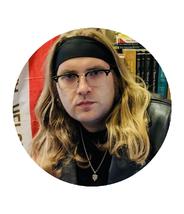by D.W. White
February 15, 2022
D.W. White is a graduate of the M.F.A. Creative Writing program at Otis College in Los Angeles and Stony Brook University's BookEnds Fellowship. Currently seeking representation for his first novel, he serves as Fiction Editor for West Trade Review, where he also contributes reviews and critical essays. His writing further appears in or is forthcoming from Fatal Flaw, Twelve Winters Journal, Chicago Review of Books, Southern Review of Books, The Rupture, On The Seawall, and elsewhere. A Chicago ex-pat, he has lived in Long Beach, California for seven years, where he frequents the beach to hide from writer’s block. He can be found on Twitter @dwhitethewriter.
©2022 West Trade Review
__________________________________________________________________________________________________________________________________________________________________________
__________________________________________________________________________________________________________________________________________________________________________
__________________________________________________________________________________________________________________________________________________________________________
__________________________________________________________________________________________________________________________________________________________________________
__________________________________________________________________________________________________________________________________________________________________________
On The Human Level:Philosophy and Connection in Shelia Heti's Pure Colour
FICTION REVIEW
Stay Connected to Our Literary Community. Subscribe to Our Newsletter
Pure Color: A Novel by Shelia Heti; Farrar, Straus and Giroux ; 224 pages; $26
There is maybe nothing quite so fun for the habitual reader of contemporary fiction as a new book by a favorite author. With certain writers one forms a seemingly idiosyncratic connection, a personal rapport that creates the impression that no other author’s work hits the mark in the same way, and no other reader so astutely perceives it. This is a fiction, of course, but not by much—there are entire schools of literary thought devoted to the study of the audience’s pro- and retrospective effect on a piece of literature, and for good reason. If the point of art is to express some ineffable thing of the human condition, it follows rather simply that some of those humans will catch the drift more fully than others. Sheila Heti is a prime example of the type of following a writer can engender, having built an excellent career on mining the quotidian difficulties that make up the thematic foundation of many great writers, but with her own tools and own approach. Her latest effort, Pure Colour, fits neatly into this lineage; an off-white, somewhat wild, utterly original novel about human connection and the meaning of life as we know it.
Heti with trademark conviction in her world building opens boldly, taking the reader in her confidence as she limns Pure Colour's delightfully simple take on the creation myth. God, we are told, is simply working through his first draft of existence with this to-us rather important universe, and is principally concerned with how he might do better the next time. For those among Heti’s audience who create themselves, and thus are fully aware just how much of a first draft remains in the finished product, this is somewhat a cause for alarm, but fortunately we initial sketches don’t seem to be in danger of ever knowing the difference. The world’s populace is divided into people who come from birds, fish, and bears, each with their own predilections, strengths, and weaknesses. From this characteristically playfully poignant beginning, Heti introduces our heroine, Mira, a bird who works in a lamp shop. Mira’s temporally-vague journey through life, love, and death makes up the bulk of Pure Colour’s fictive concern, with Heti managing to build something of an entire ideologic-religious philosophy along the way.
We learn that Mira is a student, studying to be a critic, and has left home to pursue this amorphous future. While there she, along with some of her cohort, meets Annie, who is mysterious for mysterious reasons and the recipient of Mira’s largely-veiled affections. Heti, as will be no surprise to her readership, slips through these opening acts on the oblique, eschewing traditional backstory and expositional set-up for bolts of moments and slashes of philosophical insight. The direct information we do get about Mira, however, is concentrated and smooth enough to provide adequate connection and propellant:
Later, when Mira was even a little bit older, she would have been too shy to meet someone who she thought would change her life. She would have been worried about how she’d appear, or would fear that she’d embarrass herself in some way. But she didn’t think of herself as a person back then. She didn’t think of herself as someone who another person could see, evaluate, and finally judge. She simply wanted what she wanted, and she didn’t think about how her desires would reflect on her.
This early example is indicative of Heti’s style, one that devotes little space in a short book to traditional scenic work or narrative structure, but that does not fail to make the most of those moments.
While principally rendered in that cozy third-person centered around Mira, Pure Colour at times slides over into a first person discursive for its most existential passages:
It wasn’t that long ago, is the funny thing. We are, for the most part, all of us still alive. Yet none of us keep in touch with the other ones…The friends we knew from any back when—we felt content to let them slip away; to continue the traditions of the old world into now.
On moments such as this one, which come at intervals, there is a hint of Renata Adler about Pure Colour, in style and language but, too, in her conception of the borders of the novel as an art form. This slide towards the metaphysical builds as we go along and helps shape the overall atmosphere and ethos of a novel in which so much is subject to scrutiny, even the very nature of reality itself. So if the tripartite storyline of Mira, Annie, and Mira’s ailing father will to some feel malnourished, others will appreciate the range of contemplative moods and methods found among the baseline plot.
The style, structure, and foci surely will, however, occasionally test the patience and attention spans of those readers who don’t count as dyed in the wool Heti acolytes. The lack of traditional scene or set-up will doubtless inspire comments of exasperation and searches for explanation, but her core audience will find much to enjoy. A suitable final example comes later in the book when Heti, relying again on the license for first person previously established, seems to fold in a new element, something of an introspection, an examination of life and purpose:
In the middle years of life, you no longer have acmes to culture the same way you did before. You are mostly shut out. The party is happening behind a closed door…God has put a hole in your head so things like that fall out of it. Yet you keep trying to put things like that into it! There is not a hole in your head for no reason at all. There is a hole in your head for certain things, and not for certain other things. Find the things that don’t leak out and fill your head with those ones.
In the jungle of literary commentary, there lie concealed on the forest floor chasms formed by extrapolating the statements of a first-person fictive narrator to represent those of her author, pitfalls that are numerous, grievous, and porous. However, it can be said without largely fabricated comment on Heti herself that there is a similarity in Pure Colour’s latter, and because of it stronger, half to Rachel Cusk’s Second Place, in the accomplished writer’s mediation on art and its significance in the middle of her career. And it is in this way, ultimately, beyond its style, approach, and effects, that Heti’s latest novel often feels like one written especially for her longtime audience, to those readers who, like this latest heroine, are in search of true moments of human connection. And for those who’ve long found this valuable resource in the pages of Heti’s work, Pure Colour will resonate in its reflective, swift, and contemplative accomplishments.




